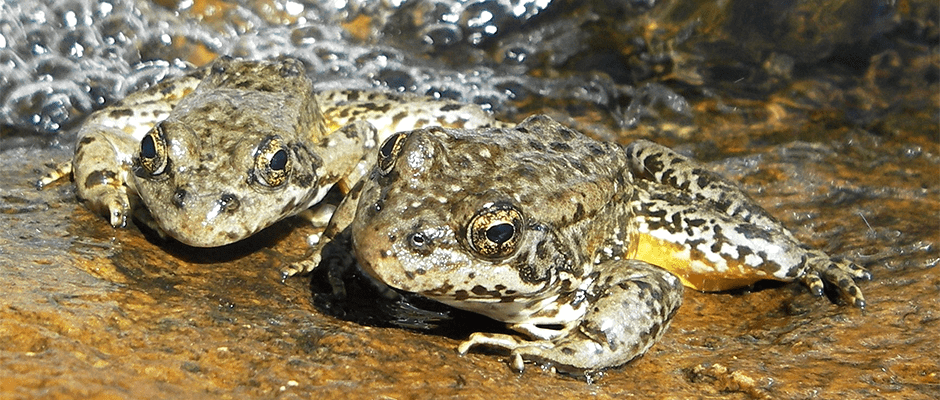Share this article
After decades of decline, could Sierra’s frogs recover?
For decades, the story of the Sierra Nevada yellow-legged frog (Rana sierrae) has been a bleak one. Once abundant in lakes and ponds in and around Yosemite National Park, the frog has been headed on a course toward extinction, first due to the introduction of nonnative fish that consumed them, and then due to the arrival of a deadly chytrid fungus.
But researchers have found new hope for the endangered frog. Surviving populations are evolving increased resistance to the disease, allowing the frogs to recolonize lakes where they’ve been extirpated.
“We need time, we need habitat that’s suitable, but given those two characteristics, if we have the resources, the funding, we can reestablish frog populations across a good chunk of their former range,” said University of California Santa Barbara ecologist Roland Knapp, who has studied the frogs for 25 years. “For amphibians in this day and age, that’s incredibly good news.”
Knapp is co-author on a recent study in the journal Ecosphere that examined the translocation of frogs that had been exposed to the deadly pathogen but appeared to have developed increased resistance to it. The frogs were taken from a large, surviving donor population in the Sierra Nevada and reintroduced to two nearby fish-free lakes in an effort to reestablish populations there.
The results were mixed. At one lake, in the more than 10 years since the frogs were translocated, their population has swelled into the hundreds. At the other, the population appears to be on the verge of disappearing again. But Knapp is optimistic. Based on results at other lakes, he said, reintroduction efforts appear to be working overall, although high rates of infection can cause some populations to fail.
“Across all of the reintroduced populations, the majority appear on their way to becoming established,” he said.
The disappearance of frogs from the Sierra Nevada is part of a global decline in amphibians due in part to the deadly chytrid fungus Batrachochytrium dendrobatidis, or Bd. Biologists believe mountain yellow-legged frogs, including R. sierrae and the closely related R. muscosa, have disappeared from over 93 percent of their historical range in the Sierra Nevada, landing them on the federal endangered species list in 2014.
“It’s been an incredible ride for these species, from being essentially everywhere there was suitable habitat to being nearly absent from their historical range,” Knapp said.
For years, the numbers continued to decline, but then some of the frogs appeared to develop a resistance to the disease. It doesn’t provide complete protection, Knapp warned. They’re still susceptible to the disease, particularly as they transform from tadpoles into subadults.
“In a large population, when metamorphosis is at its peak, you’ll find dozens of dead frogs,” he said. “But enough are surviving that the population is able to persist and recover. They haven’t evolved a perfect solution, but they’ve evolved a solution, and that’s the important thing.”
The findings suggest that if predatory fish — the frogs’ other major cause of mortality — can be eliminated from some lakes, the mountain yellow-legged frog can return, Knapp said.
“It is good news, which is rare in the world of amphibian declines,” said co-author Maxwell Joseph, a data scientist at the University of Colorado-Boulder, who handled these frogs as an undergraduate with Knapp and turned his attention to them again, developing statistical models to understand the factors driving their survival. The model revealed that data collected shortly after the translocations provide insight into the long-term viability of reintroduced populations. Knowing that can help guide future translocation efforts, he said.
“The estimates for survival that you get after a year or two might give you a pretty good idea of what might happen in five or 10 years,” he said.
Knapp believes the findings may resonate beyond the Sierra Nevada, anywhere where frogs have developed resistance to the chytrid fungus that has devastated their populations. “I think this has implications for the recovery of frogs all around the world,” he said.
Header Image: Translocating Sierra Nevada yellow-legged frogs may help their populations rebound, despite the presence of chytrid disease. ©California Department of Fish and Wildlife








